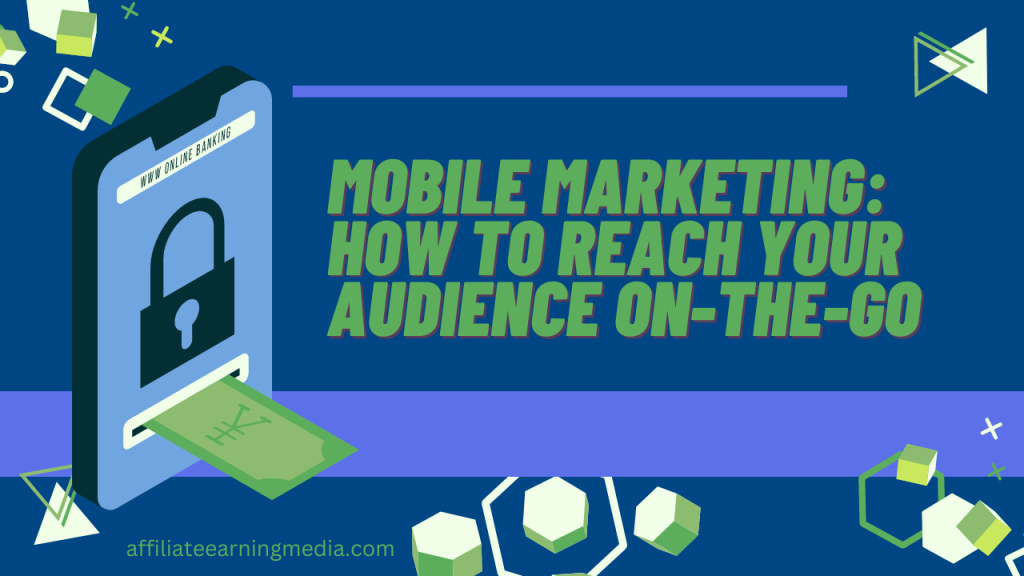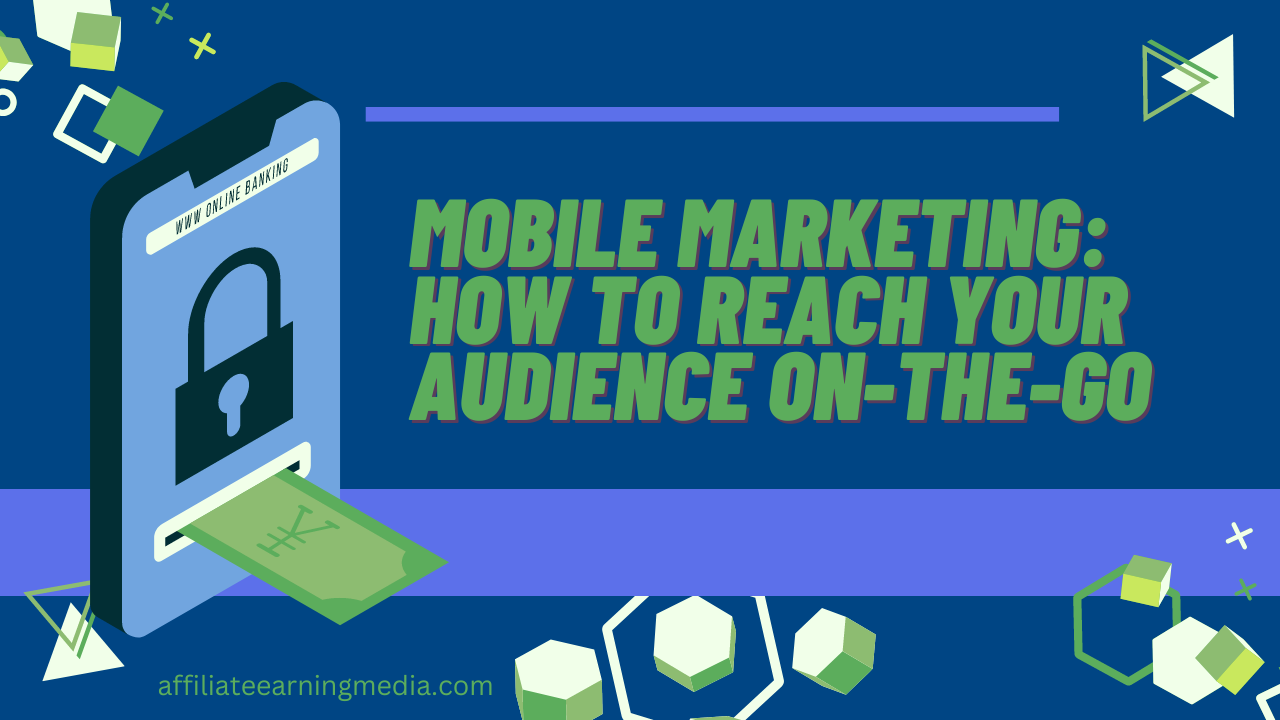Mobile marketing has become an essential tool for businesses looking to reach their audience on the go. With the proliferation of smartphones and mobile devices, consumers are increasingly turning to their mobile devices to research products, make purchases, and stay connected to the world around them. As such, businesses must develop strategies that cater to the mobile consumer, in order to remain relevant in today’s digital landscape.
Best Recommended and Proven Way to Make Money Online – Watch this FREE Video to START >>

Optimize for mobile devices
One of the most important things to keep in mind when it comes to mobile marketing is that your website and content must be optimized for mobile devices. This means ensuring that your website is mobile-friendly and loads quickly, that your content is easy to read and navigate on a small screen, and that any videos or images are optimized for mobile viewing. It’s also important to consider the user experience when designing your mobile website or app, and to ensure that it is intuitive and easy to use.
Use SMS marketing
SMS marketing is a highly effective way to reach your audience on the go. By sending targeted messages to your subscribers, you can provide them with exclusive deals, promotions, and content that they can access on their mobile devices. SMS marketing is also a great way to keep your audience engaged and informed, as it allows you to send timely updates and notifications directly to their phones.
Create mobile-friendly content
In addition to optimizing your website for mobile devices, it’s important to create content that is specifically designed for mobile consumption. This might include short-form videos, infographics, or other visual content that can be easily consumed on a small screen. By creating mobile-friendly content, you can increase engagement and encourage your audience to share your content on social media.
Leverage social media
Social media is an incredibly powerful tool for mobile marketing, as it allows businesses to connect with their audience in real-time and provide them with valuable content and insights. By leveraging social media platforms such as Facebook, Instagram, and Twitter, businesses can create targeted campaigns that speak directly to their audience and encourage engagement and interaction.
Use location-based marketing
Location-based marketing is a highly effective way to reach your audience on the go, as it allows you to target consumers based on their geographic location. By using GPS technology, businesses can create targeted campaigns that are tailored to the specific needs and interests of consumers in a particular location. This might include sending targeted messages or notifications to consumers who are in close proximity to your store, or creating ads that are tailored to the interests and behaviors of consumers in a particular area.
Conclusion:
Mobile marketing is an essential tool for businesses looking to reach their audience on the go. By optimizing for mobile devices, using SMS marketing, creating mobile-friendly content, leveraging social media, and using location-based marketing, businesses can create targeted campaigns that speak directly to their audience and provide value in the moment. With the right strategies in place, businesses can build strong relationships with their mobile audience and stay ahead of the competition in today’s digital landscape.
Optimize for mobile devices
In today’s digital age, mobile devices have become an integral part of our lives. We use them to stay connected, consume content, shop, and more. As such, it’s crucial for businesses to optimize their websites and digital content for mobile devices to reach and engage with their audience effectively. In this article, we’ll explore the importance of optimizing for mobile devices and provide some tips on how to do it effectively.
Why is mobile optimization important?
Mobile optimization is critical for several reasons. Firstly, mobile devices have become the primary means of accessing the internet, with over 50% of web traffic coming from mobile devices. Secondly, Google prioritizes mobile-friendly websites in search results, making it essential for businesses to have a mobile-optimized website to improve their visibility and search engine rankings. Finally, mobile optimization is essential to enhance user experience and ensure that your website is accessible and easy to use on a small screen.
Make your website mobile-friendly
The first step in mobile optimization is to ensure that your website is mobile-friendly. This means using responsive web design, which automatically adjusts the layout and content of your website to fit the screen size of the user’s device. Responsive design ensures that your website is accessible and easy to use on any device, whether it’s a smartphone, tablet, or desktop computer.
Simplify your design
When it comes to mobile optimization, less is often more. Simplifying your design can make it easier for users to navigate your website on a small screen. Use clear and concise language, minimize clutter, and ensure that your website is easy to navigate with large, clickable buttons and links.
In conclusion, mobile optimization is essential for businesses looking to reach and engage with their audience effectively. By making your website mobile-friendly, simplifying your design, optimizing images and videos, ensuring fast load times, and testing on mobile devices, you can create a seamless and engaging user experience that will keep users coming back to your website time and time again.
Use SMS marketing
SMS marketing, also known as text message marketing, is a powerful tool that businesses can use to engage with their audience, increase brand awareness, and drive sales. With the average person checking their phone 150 times per day, SMS marketing is an effective way to reach customers where they are and deliver targeted and personalized messages. In this article, we’ll explore the benefits of SMS marketing and provide some tips on how to use it effectively.
High open rates
Unlike email marketing, which often ends up in spam folders or goes unopened, SMS messages have an incredibly high open rate. Studies show that 98% of SMS messages are opened and read within three minutes of receipt. This makes SMS marketing an effective way to deliver time-sensitive messages or promotions that require an immediate response.
Personalized and targeted messaging
SMS marketing allows businesses to send personalized and targeted messages to their audience. By collecting customer data, such as purchase history and demographics, businesses can deliver messages that are relevant to the individual recipient. This creates a more engaging and personal experience for the customer, which can help to build brand loyalty.
Best Recommended and Proven Way to Make Money Online – Watch this FREE Video to START >>
Cost-effective
SMS marketing is a cost-effective way to reach customers. Unlike traditional advertising methods, such as television or print ads, SMS marketing has a relatively low cost per message. This makes it an ideal tool for small businesses or those on a tight budget.
In conclusion, SMS marketing is a powerful tool that businesses can use to engage with their audience, increase brand awareness, and drive sales. By following these tips and best practices, businesses can create targeted and personalized campaigns that deliver results. Whether you’re a small business or a large corporation, SMS marketing is an effective and cost-efficient way to reach your audience and achieve your marketing goals.
Create mobile-friendly content
In today’s digital age, having mobile-friendly content is crucial for any business looking to reach its target audience. With mobile devices accounting for more than half of internet traffic worldwide, businesses need to ensure that their content is optimized for smaller screens and mobile browsing habits. In this article, we’ll explore some tips for creating mobile-friendly content that engages and converts your mobile audience.
Keep it simple
When it comes to mobile content, simplicity is key. Mobile screens are smaller, and users are often browsing on the go, which means they have limited time and attention spans. Make sure your content is easy to read and understand, with short paragraphs, bullet points, and clear headings.
Use visuals
Visuals, such as images and videos, are an excellent way to break up long blocks of text and capture your audience’s attention. However, it’s essential to optimize your visuals for mobile devices by compressing images and videos to reduce file size and load times.
Use a responsive design
A responsive design is a design approach that adapts to different screen sizes and device types. A responsive website ensures that your content is displayed correctly, no matter what device your audience is using. This can help to improve the user experience and reduce bounce rates.
Optimize your website speed
Mobile users are often browsing on slower connections, which means that website speed is crucial for a positive user experience. Make sure your website is optimized for mobile browsing by reducing page load times, compressing images, and using caching.
In conclusion, creating mobile-friendly content is crucial for businesses looking to reach their mobile audience. By following these tips, businesses can create engaging and optimized content that delivers results. Whether you’re creating a website, social media content, or email marketing campaigns, it’s essential to ensure that your content is optimized for mobile browsing habits and delivers a positive user experience. By doing so, you can improve engagement, conversions, and brand loyalty among your mobile audience.
Leverage social media
Social media has become an essential component of any modern marketing strategy. With billions of active users across various platforms, social media provides businesses with a unique opportunity to reach and engage their target audience. In this article, we’ll explore some tips for leveraging social media to grow your business.
Define your target audience
The first step in leveraging social media is to define your target audience. This involves identifying the demographics, interests, and behaviors of your ideal customer. By understanding your target audience, you can create social media content that resonates with them and drives engagement.
Choose the right platforms
There are dozens of social media platforms, each with its unique features and audience. It’s important to choose the right platforms for your business based on your target audience and marketing goals. For example, if you’re targeting a younger demographic, platforms like TikTok and Instagram may be more effective than Facebook or LinkedIn.
Create valuable content
Creating valuable and engaging content is key to social media success. This includes a mix of original content and curated content from industry thought leaders. Valuable content can be anything from blog posts and infographics to videos and live streams. The key is to provide content that your audience finds useful, informative, or entertaining.
Engage with your audience
Engagement is essential to building a strong social media presence. This involves responding to comments and messages, sharing user-generated content, and participating in relevant conversations. By engaging with your audience, you can build brand loyalty, increase visibility, and drive conversions.
In conclusion, leveraging social media is essential for businesses looking to reach and engage their target audience. By defining your target audience, choosing the right platforms, creating valuable content, engaging with your audience, using social media advertising, and analyzing your results, you can create a successful social media strategy that drives results for your business.
Best Recommended and Proven Way to Make Money Online – Watch this FREE Video to START >>
Use location-based marketing
Location-based marketing is a powerful strategy that allows businesses to target customers based on their geographic location. By using location-based marketing, businesses can deliver personalized and relevant content to their customers, improve engagement, and drive conversions. In this article, we’ll explore some tips for using location-based marketing to grow your business.
Understand your target audience
The first step in using location-based marketing is to understand your target audience. This involves identifying the demographics, behaviors, and interests of your ideal customer. By understanding your audience, you can create targeted campaigns that resonate with them and deliver better results.
Use geotargeting
Geotargeting is a technique that allows businesses to target customers based on their geographic location. This can be done using GPS technology, IP addresses, or Wi-Fi networks. By using geotargeting, businesses can deliver personalized content to customers based on their location, such as offers or promotions for nearby stores or events.
Create location-specific content
Creating location-specific content is an excellent way to engage customers and drive conversions. This can be anything from blog posts and social media content to targeted ads and promotions. By creating location-specific content, businesses can show their customers that they understand their local area and are committed to serving their needs.
In conclusion, location-based marketing is a powerful strategy that allows businesses to target customers based on their geographic location. By understanding your target audience, using geotargeting, creating location-specific content, using location-based apps, using beacon technology, and analyzing your results, you can create a successful location-based marketing strategy that delivers results for your business.
I appreciate you reading my full article, Mobile Marketing: How to Reach Your Audience On-The-Go


